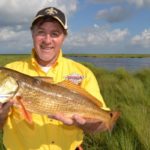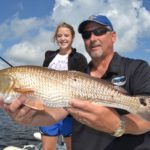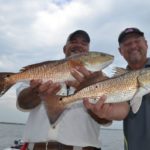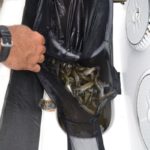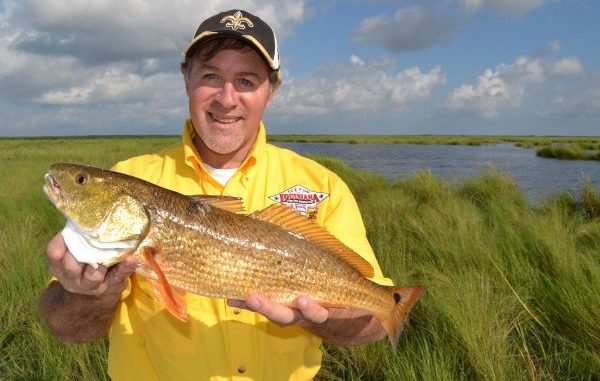
The fish-filled marshes of this Lafourche Parish town provide protection in any wind. And redfish are standing in line to pounce on your offering.
Capt. Bobby Gros enclosed the baitfish in his dripping-wet palm, and with a few wiggles of his fingertips, maneuvered it so that only its head emerged from his thick hand.
With a quick, fluid motion honed during years of repetition, he pierced the cocaho’s lower jaw with a kahle hook, and pushed the point through the top lip. Almost in the same instant, Gros opened his hand, and the minnow, thinking it had earned its freedom, wriggled violently.
Gros flicked his left wrist, and the cork-and-minnow combo — a “Leeville special,” he called it — sailed toward the edge of a broken-marsh island.
For the first few seconds, the cork danced and jostled as the minnow explored its new surroundings and tested the limits of its leash.
Soon, though, it accepted its fate, and remained mostly stationary.
Watching from the boat, Gros saw that the tide was falling and noticed some baitfish looking nervous in a nearby cove, which was really nothing more than a finger-shaped indention in the marshy shoreline. Gros reeled in his still-undisturbed cocaho, and made a long cast into the cove.
The drops from the splashdown hadn’t even reentered the water when the cork plunged, and Gros set the hook.
The rod bowed in a giant “C,” and the redfish — being hemmed in on three sides by the rim of the small cove — exploded in violent protest. Shades of deep orange and copper mixed with the tannin in the water to give almost a maroon hue to the area surrounding the fish.
Gros has fought literally thousands of redfish in his life, but he still giggled like a young boy catching his first.
The fish charged out of the cove, and made a break for the open water of the pond. Gros’ braided line, though, scoffed at the challenge. It held true, and made fast work of the 2-pound redfish.
Gros hoisted it onto the deck, unhooked it and held it up to admire it. The fish — like all reds in clean-water ponds — was richly colored and simply beautiful.
“You know, catching the big ones is fun, but if you want to eat one, this is the size you want,” he said before tossing the fish back overboard in hopes it would be available for one of his charter clients or customers of his marina — Bobby Lynn’s.
It’s next to impossible to kill a cocaho, and that redfish had failed miserably in its attempt, so Gros left the tired and banged-up baitfish on the hook. He cast into the exact same spot, and immediately hooked another fish.
That\’s just business as usual this time of year in the marshes east and west of Leeville.
“Leeville is the crossroads,” Gros said. “You’ve got Bayou Lafourche that runs right through it, but then you have the East-West Canal that runs from Grand Isle all the way out to West Timbalier or Lake Raccourci.
“The advantageous part about fishing out of Leeville is that within a 15-minute boat ride, you can fish Grand Isle to West Timbalier and up to Golden Meadow on the east or west side. It\’s all an easy run — a lot of defined canals and a lot of broken marsh right off those canals.”
Uniquely situated on the bank of Bayou Lafourche, Leeville provides protected access to ultra-productive marshes in any wind situation.
“You wake up in the morning, and you see what the good Lord has given you. Then you make the best of it,” Gros said. “Highway 1 is like a big levee. It just protects you one way or the other. On an east wind, you run west, and on a west wind, you run east.”
This time of year, of course, getting out of winds isn’t usually a high priority. The month of August — tropical systems notwithstanding — is the calmest of the year, and anglers often find themselves praying for a little breeze as they’re sweating buckshot surrounded by dead-slick, flat-calm waters.
But wind or no wind, August kicks off the season when the reds are so thick in Leeville’s marshes that it’s really difficult to pass them up to go to the big bays looking for trout.
The fish are really aggressive this time of year, particularly in the mornings and afternoons, and that fast action only builds as summer turns to fall.
The only difference between right now and October, Gros said, is that the fish are closer to the marshy shorelines of the ponds.
“The redfish are in the shallow ponds, tucked right up against the grass for two reasons,” he said. “The tides are higher (in late summer) so the bait can get into the grass, and the reds follow them.
“Secondly, the redfish get in the grass to get out of that heat. It’s a little bit of shade — just like you and I like on a hot August day.”
There’s hardly an area of any productive pond that Gros won’t fish, but he definitely focuses on different areas depending on the tidal direction.
“On a falling tide, I like to start against the banks and work the cuts,” he said. “Normally, on the points with the moving water around them, the redfish will stack up on the backside of the point in that eddy area where the water’s a little bit calmer.
“On an incoming tide, I like to work into the ponds and work the islands in the ponds as the water\’s coming around the islands.”
The great thing about this style of fishing is that anyone can do it without fear of lacking enough boat size. In fact, smaller boats are at a distinct advantage.
Kayakers frequently launch at Bobby Lynn’s and paddle just across the bayou to get into productive redfish ponds. Many return with easy limits of redfish.
The pond fishing close to his marina is so good that Gros rents kayaks — both paddle craft and Hobie Mirage Drive pedaling ’yaks — to anglers who don’t have their own.
Powerboaters, though, can cover a lot more water than kayakers, and there’s certain equipment that makes the process of finding fish much easier, Gros said.
“For fishing the marsh, a trolling motor is a must,” he said. “Also, I have a Power-Pole on both of my boats, and they make it real easy to work the marsh.”
Gros owns two bay boats, and he has no trouble locating ponds that float his boat and hold redfish, but acknowledges that newcomers to the area have to be careful.
“There\’s a lot of silting in that’s been going on over the last few years,” he said. “Most of the canals will hold anywhere from 4 to 5 feet of water. The ponds vary from 6 inches to some ponds — like the one we’re fishing today — that will have 4 feet of water.”
There are definitely fish in those skinny-water ponds, but Gros likes the ones with a little more water in them, particularly as the season progresses.
“The reds will sit on the edge of the deeper water, and as the sun comes up during the fall and winter, they’ll move onto those shallow flats as the water warms,” he explained. “You want to look for moving water around a point or get into a pond that has water moving through some marsh islands.”
It’s really not rocket science. In fact, it’s quite easy.
“A new guy in the area can find a place to catch fish,” Gros said. “If he has any kind of instinct on what to look for as far as moving water, cuts and bait — he doesn’t necessarily need to know where buried reefs are — he’ll do well.
“If he’ll come down and just use bass techniques, just pounding every pocket, every little-bitty point and working constantly, he’ll pick up a bunch of fish.”
Fish Leeville this month, and the dog days of August might just become your favorite time of year.
